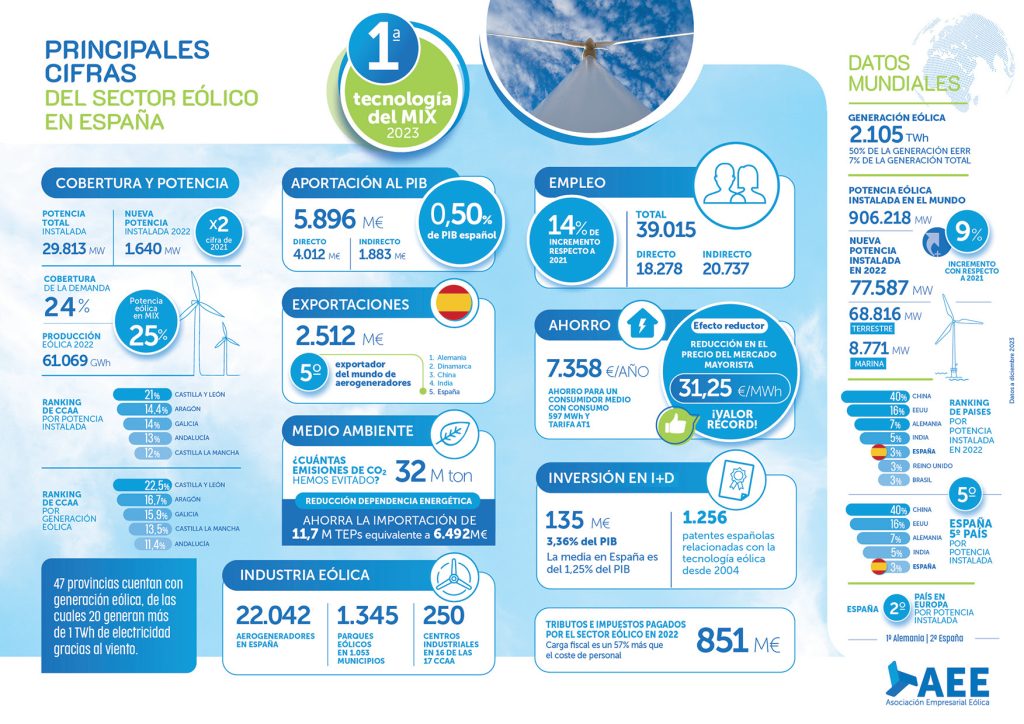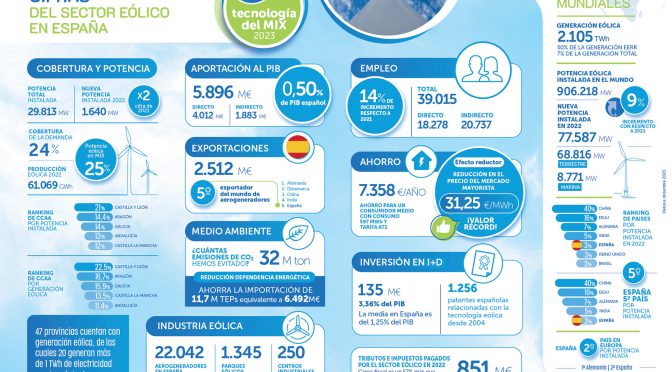The wind sector accounts for 0.50% of the GDP in Spain (0.49% previous year), generates more than 39,000 jobs (32,000 previous year, a 14% increase), exports more than 2,500 million euros and saves 6,492 million of euros in the import of fossil fuels. Thanks to wind power, the emission of 32 million tons of CO2 into the atmosphere is avoided.
The pace of wind power installation in 2022 (1,640 MW) is higher than the 2021 figure, but it is not adequate to comply with the PNIEC path. We are below the pace necessary to meet the Spanish and European objectives.
The Macroeconomic Study of the Impact of the Wind Sector in Spain, prepared by Deloitte for the Wind Business Association (AEE), aims to analyze the impact that the wind sector has on the Spanish economy. This new Study includes data on the contribution of wind energy in the different autonomous communities.
2022 was a relevant year for wind energy in Spain with an increase in power of 1,640 MW. As of December 31, 2022, Spain had 29,813 MW of wind power in total. Wind generation was 61,069 GWh, which represents a demand coverage of 24%. Wind energy was the second generation technology.
The main indicators of the wind sector in Spain
In 2022, wind generation was 61,069 GWh, which represents 24% demand coverage. In this way, wind energy was the second technology in the energy mix.
Wind power has gone from 8% in 2005 to 24% in the last year in the coverage of demand with wind power.
The total contribution of the wind sector to the GDP, adding direct and indirect, reached €5,896 million, 0.50% of the GDP in Spain. The direct contribution of the wind sector to Spain's GDP in 2022 amounted to €4,012 million, while the indirect contribution amounted to €1,883 million.
The sector employs 39,015 people (18,278 direct jobs and 20,737 indirect jobs). The increase in employment compared to the previous year is 14%.
In 2022, export activity amounted to €2,512 million. Spain is the fifth gross exporter of wind turbines in the world, behind Germany, Denmark, China and India.
In 2022, wind energy saved the import of 86 million barrels of oil equivalent (11.7 million toe), worth €6,491.7 million. This is equivalent to the natural gas transported by 147 LNG tankers.
In terms of reducing greenhouse gas emissions, in 2022 32 million tons of CO2 were no longer emitted. The value of the corresponding CO2 emission rights saved is €2,314.4 million.
The wind sector continues to bear a significant tax burden. For every €1,000 of income, €123 is dedicated to tax and tribute payments.
In 2022, the wind sector made investments in R&D equivalent to 3.36% of its contribution to the Gross Domestic Product: €134.9 million.
Wind generation has a reducing effect on electricity prices and on the sector's own income. The use of wind power instead of fossil fuels saved Spanish consumers €7,358 million in 2022 (€31.25/MWh), due to the reduction in the electricity market pool price.
Wind power in the Autonomous Communities
Wind farms in Spain are located in practically all autonomous communities. In Spain there are a total of 8,135 municipalities and 1,053 have a wind installation. 10% of Spanish municipalities have a wind farm, and 11% of the Spanish population lives in municipalities where there are wind farms.

Wind power is concentrated in five autonomous communities with 79% of the total: Castilla León, Aragón, Castilla-La Mancha, Galicia and Andalusia. These five, of the 17 Autonomous Communities, accounted for 74.8% of the contribution to the GDP, being Castilla y León, with 19.8%, Galicia, with 19%, Aragón with 14.3%, Castilla- La Mancha with 11.3% and Andalusia with 10.3%.
The provinces with the greatest presence of wind farms are Lugo, with 51% of the municipalities with a wind presence, Las Palmas de Gran Canaria, with 47%, or La Coruña with 46%.
In Zaragoza, only 17% of the municipalities host a wind farm, while 81% of the population lives with them. This is because there are several wind farms in the municipality of Zaragoza, where 70% of the province’s population lives.
In Galicia, the percentage of municipalities with wind farms amounts to 35%, a value much higher than the 21% of the population that lives in these municipalities. This indicates that parks are developed in smaller municipalities.
It can be noted that the provinces in which the largest amount of population is located in a municipality with wind power are Albacete (82%) and Zaragoza (81%), followed by Valladolid (with 63%), Palencia (with 61 %), and Las Palmas de Gran Canaria (with 49%).
Analyzing the number of provinces, it can be concluded that wind farms tend to be located in municipalities where the population is lower (Empty Spain), helping to establish population, given that they generate economic activity and employment.
Conclusions and challenges of the wind sector in Spain
Spain's commitment to wind power has turned out to be the country's best investment in the energy field in the last 20 years. The net balance is clearly positive towards technology due to the benefits it brings to the economy and society.
The wind sector is strategic for the economy and the industrial and technological autonomy of our country. Its contribution to the GDP is equivalent to that of other “Spain brand” sectors. The contribution to the GDP of this year analyzed exceeds the previous ones, standing at 0.50%
The increase in employment in 2022 compared to the previous year is 14%, more than 39,000 professionals. The wind sector contributes to the country's employability. In the Autonomous Communities where there is wind power, the unemployment rate is lower, which helps anchor the population in the rural environment.
The annual rate of installation of wind power is lower than that necessary to meet the national and European objectives for the integration of renewables. Accelerating “wind permitting” must be a priority in addition to giving signals of regulatory stability to attract financing to our country and avoid industrial relocations in the future.
It is necessary to invest in the repowering of wind farms. Aspects such as the declaration of the parks to be repowered as “assets of priority public interest”, the “additional environmental impact assessment” and compliance with the maximum processing times established in Europe must be implemented in our country.
It is critical to advance electrification to use the full potential of renewables and implement decisive policies that facilitate the growth of electricity demand in accordance with the scenario established by the PNIEC. Advancing planning and management policies for renewable deployment, storage, and renewable hydrogen in a synchronized manner must be a priority.
It is urgent to protect our wind supply chain against pressure from third markets (mainly China) to lead global manufacturing capacity. To maintain the industrial fabric and the international role of the Spanish wind industry (5th country in wind turbine exports in the world) it is necessary to implement policies at national and European level, ambitious and agile, that offer stability and protection compared to other markets. The European Wind Power Action Plan must be implemented in Spain as quickly as possible.
It is necessary to approve the regulatory framework for offshore wind and call the first auction in Spain. 2024, year of take-off of offshore wind energy in Spain. Floating offshore wind is an opportunity for the country due to the creation of new jobs and synergies with other industrial activities, such as the naval or port industries, among others. The PNIEC identifies as specific challenges the installation of at least 3 GW of offshore wind in 2030 and to achieve this we must have the first auction throughout 2024.
Dialogue and social consensus are essential for raising awareness, knowledge and acceptance of renewable projects in the territories. It is the responsibility of everyone (companies, administrations and local communities) to join forces to advance the development of wind farms, providing pedagogy, working in advance and avoiding scenarios of political use of renewable energies.
Consulta AQUÍ el Estudio Macroeconómico del Impacto del Sector Eólico en España + infografía resumen + gráficos + resto de documentación


